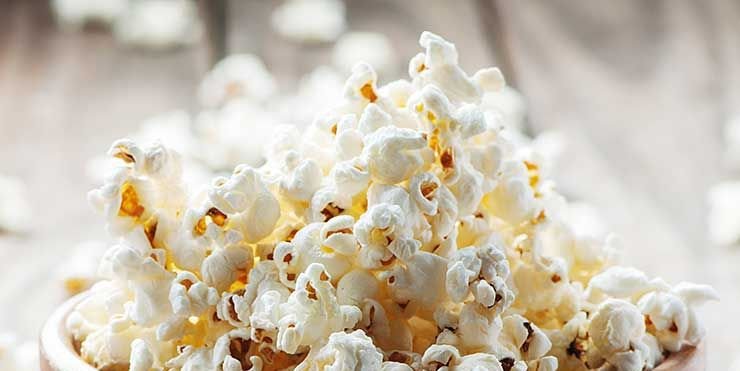Is Popcorn Healthy? – Health Benefits of Popcorn – Prevention.com
We may earn commission from links on this page, but we only recommend products we back. Why trust us?
We explore whether popcorn is really the low-calorie snack you should be reaching for.
Whether you’re craving a quick afternoon snack or need something to munch on while you binge-watch Netflix, popcorn may be your go-to snack. But is popcorn healthy? “For the most part, yes,” says Deborah Cohen, D.C.N., R.D.N., associate professor, department of clinical and preventive nutrition sciences at Rutgers School of Health Professions. “It provides about 3 grams of fiber per cup. Considering we usually eat more than one cup per sitting, that’s a good start toward the minimum of 25 grams most Americans need per day.” Fiber not only helps you feel full and satisfied, but it can improve blood cholesterol levels and lower your risk of heart disease and stroke.
Here’s what else you need to know about this popular snack:
“Most people don’t realize it’s a whole grain, which provides the fiber,” says Marisa Moore, M.B.A, R.D.A, L.D., a culinary and integrative dietician. “Besides the small amounts of nutrients such as B vitamins, iron and magnesium, popcorn also contains a variety of polyphenols.” Polyphenols are a type of antioxidant which is linked to better circulation and digestive health. Another plus? Popcorn is inexpensive and available everywhere. Plus, you know exactly what’s in it because it doesn’t contain any weird hard-to-pronounce chemicals.
Without a doubt, air-popped popcorn is the best type to nosh on. “It’s low in calories, about 90 calories a cup and is fast and easy to make,” says Cohen. You can use a small countertop air popper appliance, or look for microwaveable bowls, which allow you to pop and serve in the same bowl. It’s totally fine to add a drizzle of butter or a dash of salt, if you like; you’ll use far less than you’d get in pre-packaged varieties, says Cohen.
The next best way to pop up a batch is to do it on the stovetop. Pour about 1 tablespoon or two of olive, walnut or avocado oil (avoid coconut, flax, and palm oils, which are high in saturated fats) in a deep saucepan, and swirl it around. Heat the oil, then add enough popcorn to cover the bottom of your pan. Keep the heat on medium-high. Move the pan back and forth on the burner so the popcorn doesn’t burn or stick. It’s ready when the popping noises slow down to every few seconds. Don’t worry un-popped kernels; you typically have a few.
Popcorn is an unprocessed whole grain which contains 3 grams of fiber per prepared cup. Because you’ll probably eat more than one cup, that’s a great start toward the 25 grams or more most of us need daily, says Cohen.
It also contains small amounts of nutrients such as folate, niacin, riboflavin, thiamin, B vitamins, iron and magnesium. The popcorn hulls are the source of much of the nutritional value, including antioxidants such as beta-carotene, lutein, zeaxanthin, and polyphenols, which have anti-inflammatory properties.
Popcorn also is low in calories (about 90 per cup of air-popped), so it’s a “fast food” that isn’t full of preservatives. Plus, because of its crunch factor, it helps your brain register you’re full and satisfied, says Moore. It’s also gluten-free, low fat, and non-GMO.
Popcorn contains the following vitamins and minerals, according to the USDA:
It might seem convenient, but microwave popcorn can be laden with fat and sodium, and there’s a wide variation as far as what brands contain. “Some brands have as much as 10 grams of fat for 2 cups, which is enormous for one serving,” says Cohen. “That’s about the same amount as what’s in potato chips.” If you do choose the microwaveable types, read the label and aim for brands with sodium at less than 200 mg per serving and the fewest number of fat grams you can find (unfortunately, that’s often still around 6 or 7 grams per serving).
Pre-popped or pre-packaged bags are convenient snack to grab on the go. But they also may not be that great for you. Again, read the label and try to find those that fit into your daily nutritional needs, such as the least amount of sodium you can find, says Moore.
And though it probably goes without saying, limit your portions of kettle corn and caramel corn, which have tons of added sugar. If you want to indulge, measure out one serving and pour it into a bowl; otherwise, it’s too easy to keep dipping your hand into the bag! Finally, movie theater popcorn is the worst of the worst: A small bag typically has about 1000 calories and a jaw-dropping 40 grams of fat, says Cohen.
Want to make healthy popcorn yourself at home? Here’s what you’ll need and how exactly to make it.
• 2 tbsp. oil
• 1/3–1/2 cup popcorn kernels (or enough to cover the bottom of the pan)
You can air-pop popcorn in a microwaveable popcorn bowl or countertop air popper, or try this easy stovetop method:
Pour 1 to 2 tbsp. olive, walnut or avocado oil (avoid coconut, flax and palm oils, which are high in saturated fats) in a heavy bottom deep pan. Cover with lid, and heat the oil on medium-high for a few minutes, then add about one third to ½ cup popcorn, or about enough kernels to cover the bottom of your pan. Cover.
Wait for the first pop, then start moving the pan back and forth on the burner so the popcorn doesn’t burn or stick. Hold in the lid in place with an oven mitt as you shake it so the popcorn doesn’t jump out of the pan. Your popcorn is ready when the popping noises slow down to every few seconds. Don’t worry about un-popped kernels; you’ll have a few. If you like, add a drizzle of melted butter and a sprinkle or two of salt. Make sure to add salt or any other seasoning (cinnamon, cayenne pepper, parmesan cheese, etc.) while the popcorn is still warm so it will
If plain popcorn is too boring for you, jazz it up with seasonings, suggests Moore. Just make sure to add while warm so it sticks to the popcorn. Another trick is to lightly spritz with water so the flavors adhere. Great combinations include: Salt, chili powder, and a splash of lime juice; parmesan cheese, garlic powder, and Italian herbs; cayenne for a little kick; balsamic vinegar for a savory punch, or cinnamon with a drizzle of dark chocolate for a sweet tooth.



